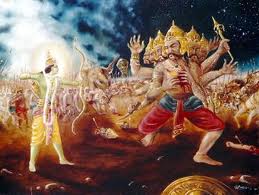The Ramayana, one of the greatest epics of ancient Indian literature, is traditionally attributed to the sage Valmiki. Composed in Sanskrit, this epic poem consists of approximately 24,000 verses divided into seven books (Kandas) and 500 cantos (Sargas). It narrates the life and adventures of Rama, the prince of Ayodhya, his wife Sita, and his loyal companion Hanuman, culminating in the battle against the demon king Ravana.
Test your knowledge on Ramayana
Valmiki is often revered as the “Adi Kavi” or the first poet, and the Ramayana is considered the first kavya (poem) in Sanskrit literature. According to legend, Valmiki was a reformed bandit who turned to asceticism and composed the Ramayana after being inspired by the grief of a bird whose mate was killed. This moment of compassion led him to create the shloka, a verse form that would structure his epic.
Various Versions of the Ramayana
While Valmiki’s Ramayana remains the most authoritative and revered version, the story of Rama has been retold and adapted into numerous languages and cultural contexts across India and Southeast Asia. These regional versions not only translate the epic but also incorporate local traditions, values, and narrative styles, enriching the Ramayana’s cultural tapestry.
Who Wrote Kamba Ramayana?
The Kamba Ramayana, also known as the Ramavataram, is a Tamil rendition of the Ramayana written by the poet Kamban in the 12th century. This version is distinguished by its lyrical beauty and depth of emotion, as well as its emphasis on devotion (bhakti) to Rama. Kamban’s adaptation diverges from Valmiki’s narrative in several ways, adding new characters and episodes, and often highlighting the ethical and philosophical dimensions of the story. The Kamba Ramayana is highly revered in Tamil literature and is celebrated for its poetic excellence and spiritual fervor.
Odia Ramayana
The Ramayana has also been adapted into the Odia language, most notably by the poet Balarama Dasa in the 16th century. Known as the Dandi Ramayana or Jagamohana Ramayana, this version is notable for its unique regional flavor and the inclusion of local folklore and traditions. Balarama Dasa’s rendition emphasizes moral and ethical teachings, making it a significant text in Odia literature and culture. Another prominent Odia version is the Bichitra Ramayana by Biswanath Khuntia, which also incorporates local elements and devotional aspects.
Other Notable Versions
The Ramayana’s influence extends far beyond Tamil and Odia cultures, with significant adaptations in various other Indian languages and even outside India. Some notable versions include:
Ramcharitmanas by Tulsidas: Written in the 16th century in Awadhi, this North Indian version is widely read and recited, especially in Uttar Pradesh and Bihar. It focuses on the devotion to Rama and is considered one of the greatest works of Hindi literature.
Adhyatma Ramayana: A Sanskrit text embedded in the Brahmanda Purana, attributed to the sage Vyasa. This version emphasizes the spiritual and philosophical aspects of Rama’s story.
Krittivasi Ramayan: A Bengali adaptation by Krittibas Ojha in the 15th century, which has become a crucial part of Bengal’s cultural and religious life.
Thai Ramakien: The Thai adaptation of the Ramayana, known as the Ramakien, illustrates the epic’s spread to Southeast Asia. This version includes unique elements and characters that reflect Thai culture and values.
Conclusion
The Ramayana, originally authored by the sage Valmiki, is a timeless epic that has inspired countless adaptations across various languages and cultures. Each version, from the Kamba Ramayana in Tamil to the Odia Ramayana, adds unique dimensions and interpretations, demonstrating the story’s universal appeal and enduring significance. The diverse renditions of the Ramayana underscore its role not only as a literary masterpiece but also as a cultural and spiritual cornerstone for many communities.
